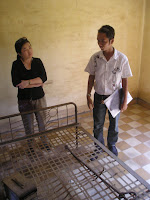 Reading the news of the first verdict at the UN-backed war crimes tribunal in Phnom Penh brought back memories of a recent visit to Cambodia. Kaing Guek Eav, better known as Duch, was sentenced today for crimes committed 30 years ago during the Khmer Rouge.
Reading the news of the first verdict at the UN-backed war crimes tribunal in Phnom Penh brought back memories of a recent visit to Cambodia. Kaing Guek Eav, better known as Duch, was sentenced today for crimes committed 30 years ago during the Khmer Rouge.Two years, during a GBGM gathering, we had toured the Tuol Sleng Museum. There we saw how innocent people, caught in the witch hunt of the Khmer Rouge, were herded into the old school grounds, boxed up in tiny brick cells and tortured on bed frames. Duch ran the notorious S21 prison, overseeing the death of up to 17,000 women, men and children, accused
 of being "enemies" of the state. That was only a fraction of Cambodians slaughtered during the period from 1975 to 1979, when over 1 million were executed or died of starvation and mistreatment.
of being "enemies" of the state. That was only a fraction of Cambodians slaughtered during the period from 1975 to 1979, when over 1 million were executed or died of starvation and mistreatment.Cambodia has captured my interest for a number of years. In 1980, as an undergraduate at Fresno Pacific College, I had a Cambodian room mate. I think his name was Tom. He was a quiet student, and as we slowly warmed to each I learned how he and his family had narrowly escaped the Khmer Rouge in 1975. Our conversations led to a growing interest in Southeast Asia that may well have influenced my current presence in Singapore.
For those who went through those terrible years and lost loved ones to such cruelty there is probably no punishment strong enough to assuage their sense of loss. Understandably, many survivors were dissatisfied with the 30 years minus 19 sentence given Duch. A shadow remaining over Cambodia is the question of how many former participants in the Pol Pot government are still in power. While the court process was long and mixed with problems, hopefully it will help the people of Cambodia to find resolution with their past.

Comments